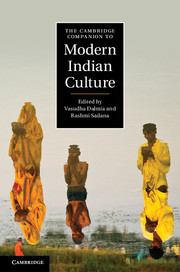Book contents
- Frontmatter
- Introduction
- Part I Cultural contexts
- Part II Cultural forms
- 6 The Bengali novel
- 7 Writing in English
- 8 Dalit life stories
- 9 National tradition and modernist art
- 10 Mass reproduction and the art of the bazaar
- 11 Urban theatre and the turn towards ‘folk’
- 12 Aesthetics and politics in popular cinema
- 13 Musical genres and national identity
- 14 Voyeurism and the family on television
- Further reading
- Index
- Cambridge Companions to Culture
9 - National tradition and modernist art
from Part II - Cultural forms
Published online by Cambridge University Press: 28 May 2012
- Frontmatter
- Introduction
- Part I Cultural contexts
- Part II Cultural forms
- 6 The Bengali novel
- 7 Writing in English
- 8 Dalit life stories
- 9 National tradition and modernist art
- 10 Mass reproduction and the art of the bazaar
- 11 Urban theatre and the turn towards ‘folk’
- 12 Aesthetics and politics in popular cinema
- 13 Musical genres and national identity
- 14 Voyeurism and the family on television
- Further reading
- Index
- Cambridge Companions to Culture
Summary
‘Notwithstanding the fact that she has studied in and been deeply influenced by the West, Miss Sher-Gil's work must be considered as a clear sign of the artistic awakening in India’, wrote the art critic Charles Fabri in 1937. Fabri, an Indologist by training and a Hungarian citizen by birth, was a partisan of modern art and Gandhian nationalism. His overwhelmingly positive review of the painter Amrita Sher-Gil's exhibition in Lahore indexed dominant understandings of Indian art, modern art and the relationship between India and the West in the 1930s. The idea that Sher-Gil's art heralded a national renaissance despite its incubation in the West reflected the way in which, by the early twentieth century, Indian art and Western art had come to be viewed as mutually exclusive cultural forms.
The idea of Indian art as decorative and fundamentally opposed to the naturalistic impulses of Western art was promoted by British colonial authorities from the middle of the nineteenth century. This opposition between Indian art and Western art was seized upon by anti-colonial nationalist artists, notably in Bengal, to produce a modern art that claimed to be ‘Indian’ by rejecting Western models. By the 1930s, when Sher-Gil came to practise art in India, however, there was a growing sense that this rejection could not by itself serve as the basis of what Fabri called an ‘artistic awakening’. There had to be a critical engagement with the forms of Western modernity alongside those of India's pre-colonial past.
- Type
- Chapter
- Information
- The Cambridge Companion to Modern Indian Culture , pp. 163 - 183Publisher: Cambridge University PressPrint publication year: 2012

